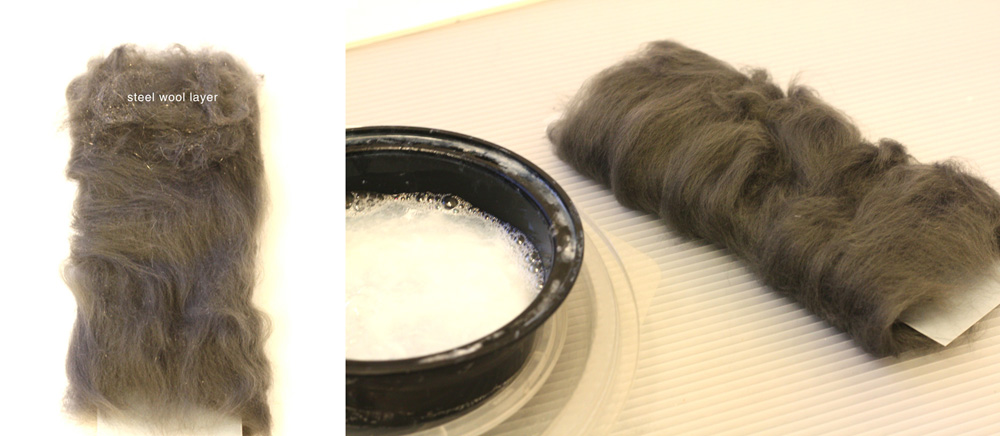Felt-me
by andreamiller
I love felting – all you need to create a tight fabric of felt is roving wool, hot water, and soap (and a lot of rubbing). When I saw a felted pompom pressure sensor during class, I was excited at the possibility of felting my own sensor.
But Arduino coding was quite new to me. I started testing with Arduino code, and made a temporary sensor/LED/lilypad combo on a piece of foam to understand the circuit layout. Sensor is made using layers of velostat, conductive thread, and conductive fabric. Tack down all parts on the foam with push pins, connect them with conductive thread, upload the code, and voila! LEDs started to blink! The arduino code makes the LEDs blink at a slow speed when the sensor is at resting state, and the speed picks up as you press/bend the felted sensor.

Now that the Arduino code and LEDs work, it’s time to make felted sensor. It turns out that I had to make multiple versions because I couldn’t get a wide range of resistance. I’ll list the different types I made. The image below shows the materials I used – merino wool roving, steel wool, and conductive thread.

Without testing, I made the hand warmer, thinking that the sensor would work. I placed the steel/merino wool mix at the tip of the hand warmer, and started felting. Couple hours later, when it was fully dry, I hooked it up to the arduino board, and.. it didn’t work. The sensor did not give a wide range of resistance. The LEDs were on full speed, as shown in the video below.
Let’s back up. It is now time to test. step by step.
_____________________________________________
TEST 1: Merino roving wool + steel wool + WET felting
This was the preferred technique, since I wanted to felt the sensor as I felted the entire project, to create a seamless piece. I didn’t want to sew on an extra layer of sensor. Thinking that I may have felted too much in the previous hand warmer piece, I felted this small test just slightly. However, when I placed the wet-felted sensor instead of the velostat sensor, the LEDs went off to its maximum blink speed again. I couldn’t get the wide range of resistance as I did with velostat sensor. Fail.
____________________________________________________
TEST 2: Merino roving wool + steel wool + NEEDLE felting
I suspected the felting method of the previous one as the main fault; wet felting technique felted the steel wool too much (similar to not having enough gap between velostat layers). So I decided to needle felt the sensor. Result? Same as above. Fail.
_________________________________________________________________
TEST 3: Merino roving wool + shredded conductive thread + needle felting.
 After some online searching of why the felted sensor did not work, I came to a conclusion that it is the steel wool itself that might be the problem. It may not be the right type to use as a sensor. So one last option was to use pulled/shredded conductive thread and felt it with the merino wool roving.
After some online searching of why the felted sensor did not work, I came to a conclusion that it is the steel wool itself that might be the problem. It may not be the right type to use as a sensor. So one last option was to use pulled/shredded conductive thread and felt it with the merino wool roving.
And…it worked! Although I didn’t get the low-mid-range resistance, I was still able to get the resting state and activated state. I took the felted piece and carefully needle felted onto a new felted hand warmer.
_________________________________
Circuit path embroidery
 Now that the felted sensor is working, I sewed the LEDs and sensor circuit path on to the felted piece using conductive thread. It was a bit difficult to separate the ground path from LED/sensor path, especially the long sensor circuit path all the way down to the analog input pin on arduino. The picture below shows the final circuit path design of the hand warmer. Each conductive thread dots (input pin locations) were pressed with snaps, so that the arduino board (which has soldered snaps on each pin locations) can be easily detached.
Now that the felted sensor is working, I sewed the LEDs and sensor circuit path on to the felted piece using conductive thread. It was a bit difficult to separate the ground path from LED/sensor path, especially the long sensor circuit path all the way down to the analog input pin on arduino. The picture below shows the final circuit path design of the hand warmer. Each conductive thread dots (input pin locations) were pressed with snaps, so that the arduino board (which has soldered snaps on each pin locations) can be easily detached.
Initial calculations:
1.1 K Ohms ~ 195.6 K Ohms
0.15 V ~ 4.24 V
Measured voltage with multimeter:
0.1 V ~ 3.8V

________________________________
LED diffuser with acrylic fishing wire

When I made the foam-board test piece, I used clear acrylic push pins to pin down the LEDs. The clear acrylic pin heads worked quite well as a diffuser, so I thought of making stitch-able light diffuser for the felted piece. I used thin gauge clear acrylic fishing wire and stitch-wrapped LED pieces. This should make the light diffuse more than the bare exposed LED heads.
_______________________________________________________
Complete: Felt-me hand warmer (use the glove to signal help with carrying your heavy grocery!)

